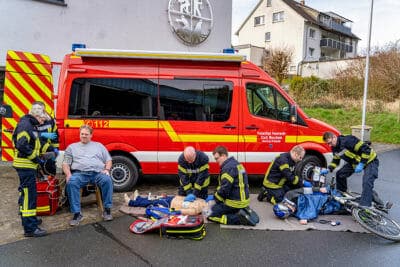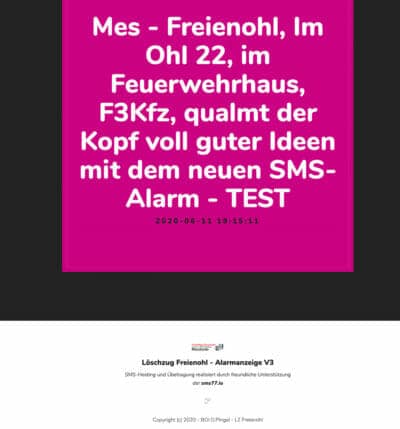Freienohl fire brigade uses inbound SMS solution to optimise the reception of alarms
When an emergency call is received by the volunteer fire brigade in Freienohl via 112, an SMS is sent to the message recipient in addition to the radio alarm. The message is then visualized on a monitor in the fire station. Initially, this had been implemented with a Raspberry Pi mini-computer, a prepaid SIM card and a GSM modem. However, the modem was already defective for the second time and also the change to Windows with an old UMTS stick proved to be rather unreliable. All in all, the transmission was a disaster: out of ten messages, usually only one arrived. So fire chief Dennis Pingel was looking for a professional SMS inbound solution that would ensure a reliable reception in the future.
The initial situation
The Freienohl Volunteer Fire Brigade (Freienohl has 5000 inhabitants) is the second largest fire brigade of 12 districts belonging to the district and university town of Meschede (30,000 inhabitants) in North Rhine-Westphalia. Each district has its own voluntary fire brigade in the Hochsauerlandkreis in municipal self-administration. Freienohl can serve five surrounding districts within a radius of 12 km as a so-called support fire brigade. The Freienohl fire brigade is called in especially when special equipment is needed for technical rescue or, for example, a fan for smoke extraction. There are a total of 60 volunteer members, whereby 30-40 comrades are a plannable size for the operations. The remaining members volunteer in the office, in training or in the youth fire brigade.

Another special feature is the basic medical training of Freienohler firefighters. This training enables them to provide initial care for injured persons until the ambulance arrives from Meschede, which usually takes 12-15 minutes. “In addition to fire protection and technical assistance, we are also active as first responders. If there is a medical emergency in our community of 5000 souls and an ambulance is called, we bridge the time until the emergency service arrives with expert medical help,” says head of the fire fighting unit Dennis Pingel.
“The reception needs to be reliable in the future”
Both the mobile reception of the modem and the reception of the SMS message on the monitor were causing problems. The script that Dennis Pingel programmed to enable the display on the monitor, on the other hand, could be implemented easily and safely. Dennis Pingel was looking for a professional alternative where the SIM card would be safely and autonomously stored outside the hall so that he would not have to worry about its functionality in future.
“Unfortunately, we have very high temperatures in the hall for structural reasons – it heats up inhumanely. In the past, this has caused permanent problems. The previous SIM card was inserted in a UMTS stick on a Raspberry Pi mini-computer. This computer was unstable and unreliable due to the hot temperatures in the hall, especially in summer.
The application case
If the control center dispatcher recognizes that an operation affects the Freienohl fire brigade, they can use an EDP system to raise the alarm. First, the radio message receivers of the volunteer firefighters are triggered and “ring”. Depending on the type of operation, different numbers of firefighters are required:
- In the event of a medical emergency, 15 comrades are usually alerted. As soon as the first 3-4 persons required are at the fire station, the fire brigade is moving out.
- In the event of a fire or traffic accident, all comrades are called to the fire station at the same time. This ensures that sufficient forces are available at any time of day or night
The fire brigade has to occupy a number of positions in its large vehicles. In a volunteer fire brigade it is common that 200-300 percent more people than needed are alerted. This is done to ensure that there is always a sufficient number of firefighters. Unlike full-time firefighters, the comrades do the missions on a voluntary basis alongside their normal work, family life and hobbies.

High temperatures in the hall caused network problems with the computer
Parallel to the notification via the radio receivers, an alarm SMS is sent from the uniform control centre. The SMS displays the most important information, such as location and type of operation. It is shown on the centrally located monitor in the fire station in Freienohl, which is housed in a reinforced concrete hall with five emergency vehicles. This information is transmitted simultaneously to the smartphone of the firefighter in charge and to the mobile phone in the command vehicle. As a third component, a smartphone app sounds the alarm, which is only accessible to the active fire brigade members. A mission report must be written after the deployment. The content of the alarm SMS is also sent by email to the inbox in Freienohl. Here, the responsible persons have the details of the operation in view immediately. This way the secretary is always informed about an operation.
The decision-making process
Especially in fire and rescue operations, every minute gained can save lives. That is why the technology used should function smoothly. “Since we have no alternative but to house the technology in the fire station, we were looking for a way to have our SIM card hosted externally. I did some research on the Internet and quickly came across the seven.io website. I liked the design of the website very much, it looks modern and appealing. Since I had hardly any experience with inbound-SMS, I contacted seven.io with my problem. The very fast support and the personal contact were also very positive”, the technical experienced firefighter describes the decision process.
Solutions and improvements
The time criterion plays an important role for the comrades – they must know where to go quickly. A glance at the monitor allows the leaders and vehicle drivers to see where the deployment site is immediately. The monitor is therefore of central importance for the successful completion of the operations.
„By now, we have been using the inbound SMS solution for six weeks. We have our own physical mobile phone number, which is available to us via the seven.io web portal. The alarm still reaches the volunteer fire brigade in Freienohl in three ways: via email, on the monitor and in the app. It is virtually the same solution, only much more reliable. The only new feature is that the alarm does not arrive directly on the computer in the hall, but first on the hosted SIM card at seven.io. Afterwards, the content is added to a MySQL database and, for data protection reasons, displayed for a limited period of time on the monitor in the vehicle hall,” says Pingel, explaining the individualized application of the API business solution from seven.io.

“The SMS notifications via seven.io are absolutely reliable and never fail”
With the well-written documentation of the API, Dennis Pingel says he has solved everything without any problems: “Describing such documentation is a form of art by itself. The implementation steps were easy to follow and to the point. The setup of seven.io was super fast, I didn’t even need a full day. Only the programming adaptation of our own script made it necessary for us to familiarize ourselves further with the API,” says the fireman happily.
Conclusion
After six weeks and 15 deployments with the hosted inbound service of seven.io, Dennis Pingel has nothing to complain about. “Yes, it is running fine and very reliably. The SMS arrives simultaneously or even 15 to 20 seconds before the radio message is received, which is really amazing. The SMS notifications have been absolutely reliable ever since and never failed. Basically we have it very easy now: Our hosted SIM card at seven.io receives an alarm SMS from our control center and we display it on the monitor and in our app. If we had not found a solution, we would only have been able to focus on evaluating the alarm dispatch. The display on the monitor as well as in our app would no longer have been possible,” concludes Dennis Pingel.